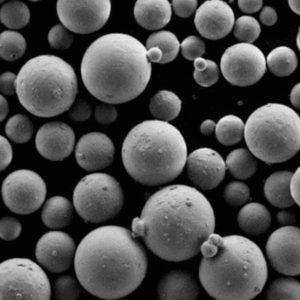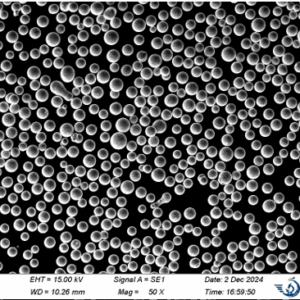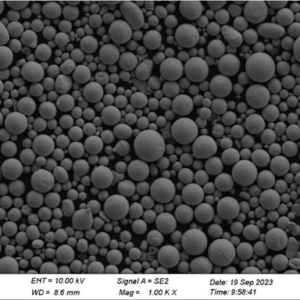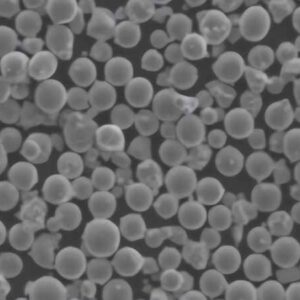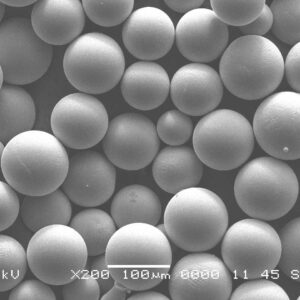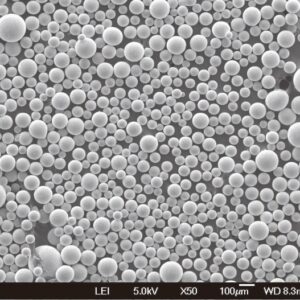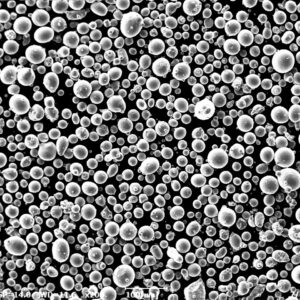멀티 레이저 인쇄 는 특히 금속 적층 제조(AM) 분야에서 제조 환경을 혁신적으로 변화시키고 있습니다. 이 공정은 높은 제작 속도, 복잡한 디자인, 효율적인 재료 사용 등 다양한 이점을 제공합니다. 하지만 최종 제품의 품질과 성능은 공정에 사용되는 금속 분말에 달려 있습니다. 파우더의 선택은 표면 마감부터 인쇄된 부품의 기계적 특성에 이르기까지 모든 것에 영향을 미치기 때문에 매우 중요합니다. 이 가이드에서는 다양한 금속 파우더 모델과 그 특성, 응용 분야 등을 살펴보면서 멀티 레이저 프린팅용 파우더의 세계를 자세히 살펴봅니다.
멀티 레이저 인쇄용 파우더 개요
"멀티 레이저 프린팅"이라는 용어는 여러 레이저를 동시에 사용하여 금속 분말을 고체 부품에 융합하는 금속 적층 제조 기술의 하위 집합을 의미합니다. 이 방법은 정밀도, 강도 및 재료 효율성이 가장 중요한 항공우주, 자동차 및 의료 기기 등의 산업에서 일반적으로 사용됩니다. 이러한 공정에 사용되는 금속 분말은 일반적으로 미세하게 등급이 매겨지며 일관된 품질을 보장하기 위해 엄격한 기준을 충족해야 합니다.
멀티 레이저 인쇄용 금속 분말의 주요 특징:
- 입자 크기: 일반적으로 10~50미크론 범위입니다.
- 구형성: 높은 구형은 우수한 유동성과 일관된 레이어링을 위해 매우 중요합니다.
- 순도: 분말은 산소와 질소 함량을 최소화한 고순도 제품이어야 합니다.
- 머티리얼 구성: 애플리케이션에 따라 다른 합금이 사용됩니다.
일반적으로 사용되는 금속 분말에는 다음이 포함됩니다:
- 스테인리스강(예: 316L, 17-4 PH)
- 티타늄 합금(예: Ti6Al4V)
- 알루미늄 합금(예: AlSi10Mg)
- 니켈 기반 초합금(예: 인코넬 718)
- 코발트-크롬 합금

분말의 구성 멀티 레이저 인쇄
금속 분말의 구성은 인쇄 공정에서의 거동과 최종 부품의 특성을 결정하는 기본적인 요소입니다. 다양한 금속 분말은 강도, 내식성 및 열 안정성 측면에서 특정 요구 사항을 충족하도록 설계되었습니다.
일반적인 금속 분말 구성:
| 금속 분말 | 구성 | 속성 |
|---|---|---|
| 316L 스테인리스 스틸 | 철(Fe), 크롬(Cr), 니켈(Ni), 몰리브덴(Mo), 망간(Mn) | 우수한 내식성, 우수한 기계적 특성, 의료 응용 분야에서 일반적으로 사용됨 |
| 17-4 PH 스테인리스 스틸 | 철(Fe), 크롬(Cr), 니켈(Ni), 구리(Cu), 니오븀(Nb) | 고강도, 우수한 내식성, 강수량 경화성 |
| Ti6Al4V(티타늄 합금) | 티타늄(Ti), 알루미늄(Al), 바나듐(V) | 높은 중량 대비 강도, 우수한 내식성, 생체 적합성 |
| AlSi10Mg(알루미늄 합금) | 알루미늄(Al), 실리콘(Si), 마그네슘(Mg) | 가볍고 열전도율이 우수하며 강도가 높습니다. |
| 인코넬 718(니켈 초합금) | 니켈(Ni), 크롬(Cr), 철(Fe), 몰리브덴(Mo), 니오븀(Nb), 티타늄(Ti), 알루미늄(Al) | 우수한 고온 강도, 내식성 |
| CoCr(코발트-크롬 합금) | 코발트(Co), 크롬(Cr), 몰리브덴(Mo), 니켈(Ni) | 높은 내마모성, 생체 적합성, 고온에서의 우수한 강도 |
| 마레이징 스틸 | 철(Fe), 니켈(Ni), 코발트(Co), 몰리브덴(Mo), 티타늄(Ti) | 매우 높은 강도, 우수한 인성, 항공 우주 및 툴링 응용 분야에 사용됨 |
| 하스텔로이 X(니켈 합금) | 니켈(Ni), 몰리브덴(Mo), 크롬(Cr), 철(Fe) | 뛰어난 고온 강도, 우수한 내산화성 |
| CuNi2SiCr(구리 합금) | 구리(Cu), 니켈(Ni), 실리콘(Si), 크롬(Cr) | 높은 전기 전도성, 우수한 기계적 특성 |
| 공구강(예: A2, D2) | 철(Fe), 탄소(C), 크롬(Cr), 몰리브덴(Mo), 바나듐(V) | 높은 경도, 내마모성, 툴링 및 금형 제작에 사용됨 |
멀티 레이저 인쇄용 파우더의 특성
멀티 레이저 인쇄에서 금속 분말의 성능은 입자 크기 분포, 형태, 유동성 및 순도와 같은 다양한 특성에 의해 영향을 받습니다. 이러한 요소는 인쇄 품질, 인쇄된 부품의 기계적 특성 및 전반적인 공정 효율성에 직접적인 영향을 미칩니다.
주요 특징:
| 특성 | 설명 | 인쇄에 미치는 영향 |
|---|---|---|
| 입자 크기 분포 | 일반적으로 10-50 미크론 범위 내에 있습니다. 미세한 파우더는 더 나은 해상도를 제공하고, 거친 파우더는 더 빠른 빌드 속도를 제공합니다. | 레이어 두께, 표면 마감 및 기계적 특성에 영향을 줍니다. |
| 형태학 | 구형 입자는 우수한 유동성과 패킹 밀도 때문에 선호됩니다. | 균일한 레이어링을 보장하고 결함의 위험을 줄입니다. |
| 유동성 | 파우더는 재코팅 과정에서 균일한 층을 형성하기 위해 자유롭게 흘러야 합니다. | 유동성이 좋지 않으면 다공성 및 불완전한 융합과 같은 결함이 발생할 수 있습니다. |
| 순도 | 산소, 질소 또는 기타 요소로 인한 오염을 최소화하는 고순도가 중요합니다. | 오염 물질은 약점, 기계적 특성 저하, 내식성 저하로 이어질 수 있습니다. |
| 구형성 | 구형도가 높으면 분말의 유동성과 포장 밀도가 향상됩니다. | 파우더 베드의 균일성을 향상시켜 고품질 인쇄물을 얻을 수 있습니다. |
| 벌크 밀도 | 분말의 부피 밀도는 주어진 부피에 포장할 수 있는 재료의 양에 영향을 미칩니다. | 파우더 사용의 효율성과 최종 부품의 무게에 영향을 미칩니다. |
멀티 레이저 인쇄용 파우더의 응용 분야
멀티 레이저 인쇄의 다양성과 다양한 금속 분말을 사용할 수 있기 때문에 이 기술은 다양한 산업에 적합합니다. 각 응용 분야는 고강도 및 내마모성부터 생체 적합성 및 열 전도성까지 특정 재료 특성을 요구합니다.
산업 애플리케이션:
| 산업 | 애플리케이션 | 선호하는 금속 분말 |
|---|---|---|
| 항공우주 | 경량 구조 부품, 터빈 블레이드 및 열교환기. | Ti6Al4V, 인코넬 718, 하스텔로이 X |
| 자동차 | 엔진 부품, 경량 구조, 내열 부품. | AlSi10Mg, 316L 스테인리스 스틸, 마레이징 스틸 |
| 의료 | 생체 적합성과 내식성이 요구되는 임플란트, 보철물, 수술 도구. | Ti6Al4V, CoCr, 316L 스테인리스 스틸 |
| 석유 및 가스 | 높은 내식성과 내마모성이 요구되는 열악한 환경을 위한 부품입니다. | 인코넬 718, 하스텔로이 X, 17-4 PH 스테인리스 스틸 |
| 툴링 및 금형 | 정밀한 기능과 긴 사용 수명을 갖춘 고강도 공구 및 금형. | 공구강, 마레이징강, 17-4 PH 스테인리스강 |
| 에너지 | 터빈, 발전기 및 기타 에너지 생산 장비용 부품. | 인코넬 718, 하스텔로이 X, CoCr |
| 전자 제품 | 방열판, 전도성 경로, 기타 우수한 열 및 전기적 특성이 요구되는 구성 요소. | CuNi2SiCr, AlSi10Mg, 316L 스테인리스 스틸 |
| 보석류 | 미적 가치가 높은 맞춤형의 복잡한 디자인. | CoCr, Ti6Al4V, 316L 스테인리스 스틸 |
| 방어 | 군용 차량, 무기 및 보호 장비용 고성능 부품. | 인코넬 718, 마레이징 스틸, Ti6Al4V |
사양, 크기, 등급 및 표준
다음 용도의 금속 분말을 선택할 때 멀티 레이저 인쇄분말에 적용되는 사양, 크기, 등급 및 표준을 고려하는 것이 중요합니다. 이러한 요소는 파우더가 의도한 용도에 대한 요구 사항을 충족하고 업계 표준을 준수하는지 확인합니다.
사양 및 표준:
| 금속 분말 | 사양/표준 | 입자 크기 범위 | 등급 |
|---|---|---|---|
| 316L 스테인리스 스틸 | ASTM F138, F139, F3184 | 15-45 미크론 | 의료 등급, 산업용 등급 |
| 17-4 PH 스테인리스 스틸 | ASTM A564, A693 | 10-50 미크론 | 강수량 강화 |
| Ti6Al4V | ASTM F1472, F2924 | 20-45 미크론 | 5등급(ELI) |
| AlSi10Mg | ISO 9001, ASTM F3318 | 20-63 미크론 | AM 등급, 고순도 |
| 인코넬 718 | ASTM B637, AMS 5662 | 15-53 미크론 | 초합금 |
| 마레이징 스틸 | AMS 6514, ASTM A646 | 15-45 미크론 | 18Ni-300 |
| 하스텔로이 X | ASTM B435, AMS 5754 | 15-53 미크론 | 고온 합금 |
| CuNi2SiCr | DIN 17666, ASTM B422 | 20-63 미크론 | 고전도성 등급 |
| 공구강 | ASTM A681, ISO 4957 | 15-45 미크론 | A2, D2 |
공급업체 및 가격 세부 정보
멀티 레이저 인쇄용 금속 분말 시장은 방대하며, 수많은 공급업체가 다양한 제품을 제공합니다. 가격은 재료, 입자 크기, 순도 및 공급업체에 따라 크게 달라질 수 있습니다.
공급업체 및 가격:
| 공급업체 | 금속 분말 사용 가능 | 가격(kg당) | 댓글 |
|---|---|---|---|
| LPW 기술 | 스테인리스 스틸, 티타늄, 알루미늄, 인코넬 | $150 – $600 | 고품질 파우더, 맞춤형 솔루션 |
| 목수 첨가제 | 스테인리스 스틸, 티타늄, 니켈 합금, 코발트-크롬 | $200 – $800 | 다양한 합금 옵션, 글로벌 공급업체 |
| 샌드빅 오스프리 | 티타늄, 알루미늄, 공구강, 스테인리스강 | $180 – $750 | 일관된 품질, 광범위한 R&D 역량 |
| AP&C(GE 애디티브) | 티타늄, 알루미늄, 니켈 합금 | $250 – $1000 | 고품질 구형 분말 전문 제품 |
| 회가나스 AB | 스테인리스강, 공구강, 코발트-크롬 | $150 – $500 | 지속 가능성과 혁신에 집중 |
| Tekna | 티타늄, 알루미늄, 니켈 합금 | $200 – $900 | 고급 플라즈마 원자화 프로세스 |
| 오베르 & 듀발 | 니켈 기반 초합금, 스테인리스 스틸, 티타늄 | $300 – $1000 | 고급 항공 우주 등급 파우더 |
| EOS | 티타늄, 알루미늄, 니켈 합금, 코발트-크롬 | $250 – $1200 | EOS 머신에 최적화된 고성능 파우더 |
| 카테크 | 마레이징 스틸, 니켈 합금, 스테인리스 스틸 | $200 – $900 | 고강도 합금에 특화되어 있습니다. |
| Ametek | 티타늄, 니켈 합금, 스테인리스 스틸 | $180 – $850 | 다양한 산업을 위한 광범위한 금속 분말 제품군 |
금속 분말의 장점과 한계는 다음과 같습니다. 멀티 레이저 인쇄
멀티 레이저 프린팅 공정을 최적화하려면 올바른 금속 파우더를 선택하는 것이 중요합니다. 각 파우더 유형에는 고유한 장점과 한계가 있으며, 이는 인쇄된 부품의 전반적인 성능에 영향을 미칠 수 있습니다.
장점과 한계 비교하기:
| 금속 분말 | 장점 | 제한 사항 |
|---|---|---|
| 316L 스테인리스 스틸 | 우수한 내식성, 우수한 기계적 특성, 널리 사용 가능 | 17-4 PH와 같은 다른 합금에 비해 강도가 낮습니다. |
| 17-4 PH 스테인리스 스틸 | 고강도, 우수한 내식성, 강수량 경화성 | 316L보다 비싸고 복잡한 열처리가 필요함 |
| Ti6Al4V | 높은 중량 대비 강도, 우수한 내식성, 생체 적합성 | 높은 비용, 산소 민감성으로 인해 인쇄하기 어려움 |
| AlSi10Mg | 가볍고 열전도율이 우수하며 강도가 높습니다. | 티타늄 합금에 비해 낮은 내피로성 |
| 인코넬 718 | 우수한 고온 강도, 내식성 | 비싸고, 인쇄 후 기계 가공이 어려운 제품 |
| CoCr | 높은 내마모성, 생체 적합성, 고온에서의 우수한 강도 | 매우 비싸고 처리하기 어려운 |
| 마레이징 스틸 | 매우 높은 강도, 우수한 인성, 항공 우주 및 툴링 응용 분야에 사용됨 | 노화 처리 필요, 제한된 내식성 |
| 하스텔로이 X | 뛰어난 고온 강도, 우수한 내산화성 | 매우 비싸고 니켈 함량이 높아 인쇄가 어렵습니다. |
| CuNi2SiCr | 높은 전기 전도성, 우수한 기계적 특성 | 강도가 제한적이며 고온 응용 분야에는 적합하지 않음 |
| 공구강 | 높은 경도, 내마모성, 툴링 및 금형 제작에 사용됨 | 올바르게 처리하지 않으면 균열이 생기기 쉬우므로 인쇄 후 열처리가 필요합니다. |

자주 묻는 질문
| 질문 | 답변 |
|---|---|
| 항공우주 분야에 가장 적합한 금속 분말은 무엇인가요? | Ti6Al4V 그리고 인코넬 718 는 높은 강도와 내식성으로 항공우주 분야에서 널리 사용됩니다. |
| 알루미늄 분말과 함께 멀티 레이저 인쇄를 사용할 수 있습니까? | 예, AlSi10Mg 는 멀티 레이저 인쇄, 특히 경량 구조물에 사용되는 일반적인 알루미늄 합금 분말입니다. |
| 입자 크기는 인쇄 부품의 품질에 어떤 영향을 미칩니까? | 입자가 미세할수록 해상도와 표면 마감이 향상되고 입자가 거칠수록 빌드 속도가 빨라질 수 있습니다. |
| 티타늄 파우더를 사용할 때 어떤 어려움이 있나요? | 다음과 같은 티타늄 분말 Ti6Al4V 는 산소에 민감하기 때문에 오염 없이 처리하기가 어렵습니다. |
| 의료용 임플란트에 가장 적합한 파우더는 무엇인가요? | Ti6Al4V 그리고 CoCr 는 생체 적합성과 내식성으로 인해 의료용 임플란트에 선호됩니다. |
| 멀티 레이저 인쇄용 금속 분말은 비쌉니까? | 예, 비용은 재료와 순도에 따라 킬로그램당 $150에서 $1200 이상까지 다양합니다. |
| 금속 분말로 인쇄한 후 후처리가 필요합니까? | 종종 그렇습니다. 원하는 특성을 얻기 위해 열처리 또는 기계 가공과 같은 후처리가 필요할 수 있습니다. |
| 내 용도에 맞는 파우더는 어떻게 선택하나요? | 강도, 내식성, 열 안정성 등 필요한 특성을 고려하고 이를 금속 분말 구성과 일치시켜야 합니다. |
| 멀티 레이저 인쇄에서 금속 분말을 재사용할 수 있나요? | 예, 그러나 일관된 품질을 보장하기 위해 재사용하기 전에 파우더를 체질하고 오염 여부를 테스트해야 합니다. |
| 금속 분말을 취급할 때 어떤 안전 예방 조치가 필요하나요? | 흡입 및 분진 폭발 위험을 피하려면 적절한 환기, 개인 보호 장비(PPE), 취급 프로토콜이 필수적입니다. |
결론
다음 용도의 금속 분말 멀티 레이저 인쇄 는 최종 인쇄 부품의 품질, 성능 및 비용 효율성을 결정하는 데 중추적인 역할을 합니다. 스테인리스강과 티타늄 합금부터 초합금 및 특수 등급에 이르기까지 다양한 소재를 사용할 수 있으므로 올바른 파우더를 선택하려면 응용 분야의 특정 요구 사항을 신중하게 고려해야 합니다. 제조업체는 이러한 분말의 구성, 특성 및 용도를 이해함으로써 공정을 최적화하고 비용을 절감하며 우수한 결과를 얻을 수 있습니다.
이 가이드는 항공 우주, 자동차, 의료 또는 금속 적층 제조를 활용하는 기타 모든 산업에서 멀티 레이저 프린팅을 위한 분말의 복잡한 환경을 탐색할 수 있는 종합적인 리소스입니다.



